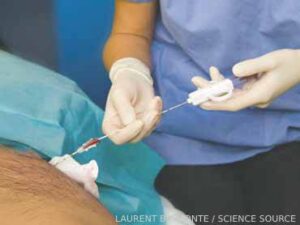 SAN DIEGO—As part of a Nov. 14 session on lupus nephritis at ACR Convergence 2023, Simone Appenzeller, MD, PhD, shared perspectives on the importance of biopsy to inform its diagnosis, prognosis and treatment, with an emphasis on childhood disease.
SAN DIEGO—As part of a Nov. 14 session on lupus nephritis at ACR Convergence 2023, Simone Appenzeller, MD, PhD, shared perspectives on the importance of biopsy to inform its diagnosis, prognosis and treatment, with an emphasis on childhood disease.
Prompt diagnosis and treatment of lupus nephritis is perhaps even more important for children than for adults because of the risk of kidney failure and longer total lifetime impact. Kidney involvement in systemic lupus erythematosus is less common in adults than children, said Dr. Appenzeller, professor in the Department of Orthopedics, Rheumatology and Traumatology at the State University of Campinas, São Paulo, Brazil. She noted that kidney involvement is present in more than half of children with the disease. When lupus nephritis occurs in children, usually within the first two years of disease onset, it’s often more severe than in adults.1
Opinions on the optimal use of kidney biopsy in both adult and pediatric lupus have been evolving. Exactly when or how often the test should ideally be employed is unclear, and practitioners continue to weigh the diagnostic benefits of the gold standard test against the risks of an invasive procedure.2 Part of the diagnostic challenge is that established, non-invasive diagnostic markers often give incomplete information. For example, traditional laboratory markers, such as anti-double-stranded DNA antibody and complement, are often poor at detecting an early lupus nephritis flare; they also possess limited sensitivity and specificity in distinguishing active disease from earlier damage. Newer blood or urine markers and marker panels may eventually provide more informative results, but these are still likely to prove supplemental to biopsy.3

Dr. Appenzeller
The risk of kidney failure in childhood lupus is between 7% and 23%, added Dr. Appenzeller, and the mortality rate of pediatric patients with lupus nephritis is 19 times higher than those without nephritis.4
Renal Biopsy
Some patients with lupus nephritis have clear clinical or laboratory signs, such as edema or overt proteinuria, but others may have subtle or no symptoms. “We now know that clinical symptoms alone are not reliable enough to reflect the severity of renal disease in lupus nephritis; therefore, a renal biopsy is needed to guide treatment strategy,” said Dr. Appenzeller.
She highlighted the treat-to-target approach recently endorsed by the Pediatric Rheumatology European Society Taskforce, which strongly recommends early recognition and treatment of renal involvement, with a low threshold for renal biopsy to help reduce morbidity and mortality rates.5

